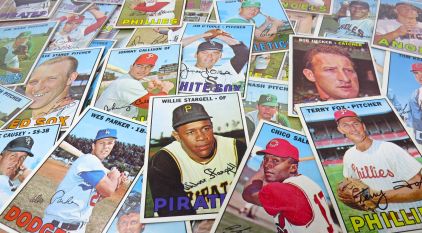What are Baseball Cards?
A baseball card is a baseball-related trading card, usually printed on some sort of paper or stock card. A card will typically feature one or more baseball players or other baseball-related sports figures.
This card is most popular in the United States, but is also popular in countries such as Canada, Cuba, and Japan, which have top leagues with significant fan bases supporting them. Some prominent companies for making these cards are Topps, Upper Deck, Fleer, Donruss, Bowman, and Playoff Contenders.
Baseball cards can be collected a lot. Many antique stores sell a variety of baseball cards. One of the reasons baseball cards are collectible is because they have been around for a long time. Some baseball cards can be worth millions of dollars.
Baseball cards were first issued in the 1880s and used for promotion by tobacco companies. Although it also served to reinforce the soft packs of cigarettes, its primary function was advertising, and as early as 1887 cards and cigarettes were converted into stiffer “slide and shell” boxes that did not require reinforcement.
They were packed. Card designs and formats vary, but most are 2 5/8 x 1 1/2 inches, much smaller than today’s trading cards. Two exceptions are the large format set of Turkey Red and Old Judge cabinets.
These are created as a premium in exchange for coupons distributed with packs of cigarettes. Issued with either black-and-white photographs or color prints, the cards feature baseball players in both action scenes and formal poses.
What were the Most Valuable 80s Baseball Cards?
Baseball trading cards are now rated by the Professional Sports Authenticator (PSA) on a scale of 1 to 10, showing how well they have held up over the years. This grade greatly affects the value of a baseball card.
Randy Johnson
Randy Johnson was selected by the Atlanta Braves in the 1982 MLB Draft, shortly after graduating from high school. But he turned down that offer, instead accepting a baseball scholarship to the University of Southern California.

He joined MLB in 1988 and played for six different teams. His massive height of 6 feet 10 inches has earned him the nickname “The Big Unit”. Johnson was on the field for a surprisingly long time as a pitcher, playing until the age of 40.
A 1989 Randy Johnson card with mint condition from Topps sold for $72 after attracting 28 auctions on eBay in August 2022. The seller, of Passaic, New Jersey, added several details on the offer page, but specifically the article is attached in a PSA – plastic box for peace of mind protection.
John Smoltz
The unforgettable John ‘Smoltzie’ Smoltz spent 22 seasons in Major League Baseball in the 80’s, 90’s and 00’s. He spent most of his career with the Atlanta Braves, winning eight All-Star titles. Among his many records and achievements, Smoltz was the franchise record holder for his 10-year career savings.
In 1989, the Upper Deck released John his Smoltz rookie card, capturing the imagination of fans. Another signed listing had a copy listed on his eBay, where he sold for $650 in August 2022.
Pete Rose
Peter Edward Rose Sr, also known as Charlie Hustle, wowed crowds from 1963 to 1986, primarily playing with the Cincinnati Reds. In the mid to late 80s, he also became their manager. He’s the MLB’s all-time leader in hits and games played. He later confessed to betting on baseball games, which led to a series of demands for his various titles to be stripped.
Topps created a prominent Pete Rose card in 1980, with a close-up image of the player’s face. After the eBay auction ended in October 2022, a copy sold for an impressive $1,800. This seller is particularly experienced on the auction site, with 1,056,117 reviews. They are based in Passaic, New Jersey.
Why Are Baseball Cards Worthless Now?
The baseball card was a great card when it was first released, but today no one can make it through college let alone buy a ham sandwich. The value of sports cards in the late 1980s and early 1990s is almost nonexistent, with a few notable exceptions.
The shopkeeper continues to politely flip through the cards, while the collector, completely overcome by the vision of wealth to come, points out obvious newcomers such as Greg Vaughan, Greg Jeffries, and Kevin Mars.
Anyone who wanted a 1991 Michael Jordan upper floor baseball got three. Even if there’s only one in each box, there are tons of them. Literally. Today, they can be found for pennies on the dollar. The same goes for most sports cards manufactured between 1986 and 1992.
As sports cards started to emerge as collectibles, more and more people started buying them. Soon, price guidelines appeared that assigned specific values to collections. The hobby then experienced exponential growth.
People suddenly dream of Jose Canseco and Todd Van Poppel cards that work like stocks. Sports card values are expected to steadily increase, eventually culminating in money for college tuition, new cars, and lavish weddings.
A large supply should have been a key clue to the impossibility of continued growth in the value of sports cards.As hobbyist collectors dried up, supply far exceeded demand. The swarm of cards never disappeared. It sat in a closet for years, collecting dust.
It was long ago that supply caught up with demand. Baseball cards are worthless because no one buys them.

